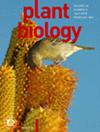CBF1 is an underestimated plant regulatory transcription factor
IF 3.6
3区 生物学
Q1 PLANT SCIENCES
引用次数: 0
Abstract

CBF1是一种被低估的植物调控转录因子。
CBF1转录因子因其对植物抗逆性的显著贡献而被广泛应用,帮助植物应对复杂的非生物胁迫。然而,它们对植物类型和其他性状的调控作用往往被忽视。我们在棉花中过表达蒙古Ammopiptanthus mongolicus CBF1基因。成功获得了L28、L30和L41三个高表达的转基因品系。随后,我们全面研究了棉花的多种表型,包括株高、整体形态、叶片形状、叶片颜色和叶片厚度。此外,我们还分析了激素水平、产量和纤维质量。通过对比分析发现,与野生棉花相比,过表达植株根系结构较强,结构矮化紧凑,叶缘锯齿状,叶组织较厚,叶颜色较深。此外,IAA和GA3也显著降低。过表达植株表现出许多性状的改变,这些改变都是由AmCBF1调控的。对作物地上部植物形态的研究是了解作物生长和产量的必要条件。值得注意的是,尽管CBF1在介导抗逆性中发挥了突出作用,但它在影响植物结构和其他性状方面的重要性却被忽视了。因此,探索CBF1在植物发育中的多种作用将是未来研究的关键。
本文章由计算机程序翻译,如有差异,请以英文原文为准。
求助全文
约1分钟内获得全文
求助全文
来源期刊

Plant Biology
生物-植物科学
CiteScore
8.20
自引率
2.60%
发文量
109
审稿时长
3 months
期刊介绍:
Plant Biology is an international journal of broad scope bringing together the different subdisciplines, such as physiology, molecular biology, cell biology, development, genetics, systematics, ecology, evolution, ecophysiology, plant-microbe interactions, and mycology.
Plant Biology publishes original problem-oriented full-length research papers, short research papers, and review articles. Discussion of hot topics and provocative opinion articles are published under the heading Acute Views. From a multidisciplinary perspective, Plant Biology will provide a platform for publication, information and debate, encompassing all areas which fall within the scope of plant science.
 求助内容:
求助内容: 应助结果提醒方式:
应助结果提醒方式:


